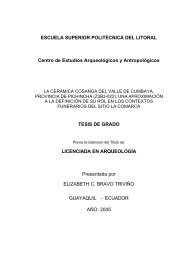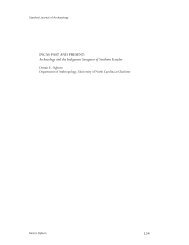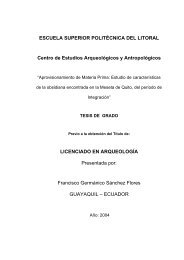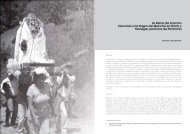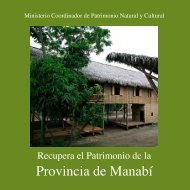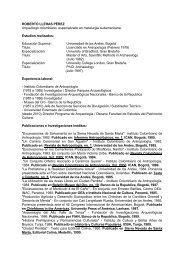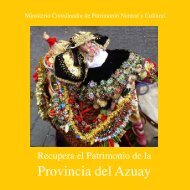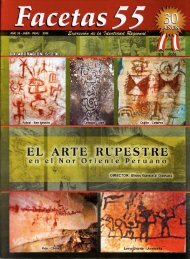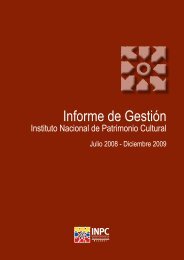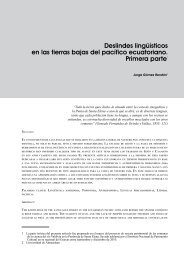Cuadernos de Investigación 8 (PDF) - ArqueologÃa Ecuatoriana
Cuadernos de Investigación 8 (PDF) - ArqueologÃa Ecuatoriana
Cuadernos de Investigación 8 (PDF) - ArqueologÃa Ecuatoriana
Create successful ePaper yourself
Turn your PDF publications into a flip-book with our unique Google optimized e-Paper software.
DESARROLLO CULTURAL PREHISPÁNICO EN<br />
EL VALLE DEL ALTO UPANO:<br />
Análisis Cerámico <strong>de</strong>l Sitio “La Lomita”, Morona Santiago,<br />
Ecuador.<br />
Estanislao Pazmiño N.P.<br />
Resumen<br />
El presente artículo se encuentra basado en el trabajo <strong>de</strong> investigación realizado como parte <strong>de</strong> mi<br />
disertación <strong>de</strong> grado. El estudio se <strong>de</strong>sarrolló a partir <strong>de</strong>l análisis <strong>de</strong> la colección cerámica <strong>de</strong>l sitio La<br />
Lomita en la zona <strong>de</strong>l Alto Upano, amazonía ecuatoriana. La región presenta evi<strong>de</strong>ncia <strong>de</strong> una fuerte<br />
ocupación prehispánica que ha sido expuesta en varias investigaciones anteriores (Porras, 1985, 1987,<br />
Salazar, 1998, 1999, 2000; Rostain, 1999a, 1999b, 1999c, 2006). Aunque en principio se estableció<br />
una larga presencia <strong>de</strong>l grupo cultural Upano (Porras, 1987), recientes investigaciones (Rostain, 1999b,<br />
2006) confrontan esa información y plantean la existencia <strong>de</strong> al menos dos claras ocupaciones: Upano y<br />
Huapula. Con ello quedó expuesta la posibilidad <strong>de</strong> que en la región exista evi<strong>de</strong>ncia <strong>de</strong> más ocupaciones.<br />
El presente trabajo confirma la existencia <strong>de</strong> tres conjuntos cerámicos distintos registrados en el sitio La<br />
Lomita: Sangay, Upano y Huapula. La <strong>de</strong>finición <strong>de</strong> estos conjuntos cerámicos, sugiere la existencia <strong>de</strong><br />
distintos períodos <strong>de</strong> ocupación <strong>de</strong>l valle en los que la interacción con la zona andina se <strong>de</strong>sarrolló en<br />
diferentes escalas.<br />
Abstract<br />
The present article is based on an investigation that was part of my dissertation. The study <strong>de</strong>veloped<br />
following the analysis of the ceramics collection of La Lomita in the Alto Upano region of the Ecuadorian<br />
Amazon. The region presents evi<strong>de</strong>nce of a strong pre-Hispanic settlement that has been studied in<br />
various previous investigations (Porras 1985, 1987, Salazar 1995, 1998, 1999, 2000, Rostain 1999a,<br />
1999b, 1999c, 2006.). Although at first the lengthy presence of the Upano cultural group was established<br />
(see Porras 1987), recent investigations (Rostain 1999b, 2006) confront this information and propose the<br />
existence of at least two clear settlements: Upano and Huapula. These studies exposed the possibility<br />
that there is evi<strong>de</strong>nce in the region of even more settlements. The present work confirms the existence of<br />
three different ceramic groupings registered in La Lomita: Sangay, Upano, and Huapula. The <strong>de</strong>finition<br />
of these ceramic groupings suggests the existence of distinct periods of settlement in the valley, in which<br />
the interaction with the An<strong>de</strong>an region <strong>de</strong>veloped on different scales.<br />
La investigación arqueológica en la región amazónica ecuatoriana es relativamente<br />
nueva en el ámbito científico. Diversos trabajos se han <strong>de</strong>sarrollado en la región<br />
con interesantes aportes a la comprensión <strong>de</strong>l <strong>de</strong>senvolvimiento cultural. A<br />
pesar <strong>de</strong> ello, los investigadores han enfrentado diferentes problemas, sobre todo <strong>de</strong>bido<br />
a que la evi<strong>de</strong>ncia preservada en el registro arqueológico es limitada; por lo que gran parte<br />
<strong>de</strong> la cultura material recuperada en la amazonía correspon<strong>de</strong> a restos cerámicos.



